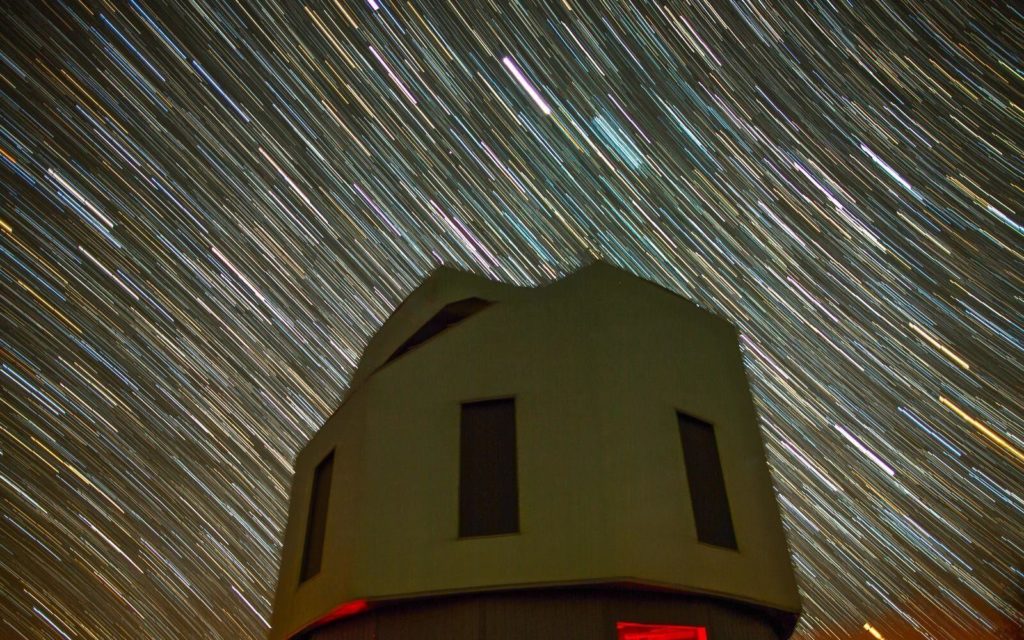
The image shows star trails over the Lowell Discovery Telescope dome. | Joe Llama
As posted on the Arizona Daily Sun website on 3/26/2022.
Aluminum is traditionally used to commemorate 10-year anniversaries. That’s appropriate for such a recognition on April 3 as the preeminent research telescope in these parts — the Lowell Discovery Telescope (LDT) — turns 10. To be specific, April 3, 2012 was the date of “first light” for LDT, when scientists and engineers first used the fully assembled telescope to image the sky. And why is aluminum appropriate? Because the critical coating on the massive primary mirror used for collecting photons of light is composed of that material.
To celebrate this anniversary, here is the LDT by the numbers. Well, 10 numbers: one for each year of LDT operation.
5 – The number of partner institutions with regular access to the LDT. Lowell Observatory owns and operates the telescope, but has formed these scientific partnerships to help maximize research with the LDT. The partners include: Northern Arizona University, Boston University, the University of Maryland, Yale University, and the University of Toledo. Five is also the number of instruments that the LDT’s revolutionary instrument cube can hold at one time. This allows for essentially simultaneous use of all these instruments, making the LDT one of the most versatile telescopes in the world. As former Lowell Director Dr. Bob Millis put it, the LDT is the “Swiss Army Knife” of telescopes.
36 – The number of megapixels in the massive CCD of the Large Monolithic imager, which is the LDT’s workhorse camera. In fact, this is the largest CCD that can be made with current manufacturing techniques. CCD stands for charged-coupled device; such mechanisms are used for high-quality image sensing in digital cameras and video recorders.
42 – The number of miles (driving) from Flagstaff City Hall to the Lowell Discovery Telescope.
73 – The height, in feet, of the LDT’s metal dome, which measures 62 feet in diameter. The facility is typically visible from 30+ miles away.
100 – The average thickness, in nanometers, of the aluminum coating on the primary mirror. This is 1,000 times thinner than typical 0.1-millimeter-thick copy paper! 100 is also the number of Earth-sized planets scientists plan to discover by using the LDT in conjunction with a powerful instrument built by Yale University called the EXtreme PREcision Spectrometer (EXPRES).
120 – The number of devices called actuators that are spread around the bottom of the LDT’s primary mirror. These are attached to sensors and hold, support, and control the shape of the primary mirror.
170 – The current number of published professional research papers using LDT data. The number has actually surpassed this, and the papers have been authored by scientists from around the world.
6,700 – The weight, in pounds, of the LDT’s primary mirror, which measures 4.3 meters (just over 14 feet) in diameter and 10 centimeters (nearly 4 inches) thick. Why doesn’t this extremely thin mirror bend under its own weight? See 120 above. By the way, the telescope’s secondary mirror measures 1.4 meters (a bit more than 4 ½ feet) in diameter and weighs 500 pounds.
7,740 – The elevation, in feet, of the terrain on which the LDT facility sits.
53,000,000 – The cost, in dollars, of building the LDT and associated facility. The telescope was originally called the Discovery Channel Telescope, in honor of the instrument’s naming sponsor, Discovery Communications. The name Discovery is still included in the current name, to both continue honoring Discovery Communications and also as a nod to the discoveries being made with the telescope.